MARHy Wind Tunnel
The MARHy Hypersonic low density Wind Tunnel, located at the ICARE[1] Laboratory in Orléans, France, is a research facility used extensively for fundamental and applied research of fluid dynamic phenomena in rarefied compressible flows. Its name is an acronym for Mach Adaptable Rarefied Hypersonic and the wind tunnel is recorded under this name under the European portal MERIL.[2]
The facility was completed in 1963 and is one of the three facilities belonging to the FAST platform (composed of two other wind tunnels) and used in the aim of supporting aeronautics and aerospace research.
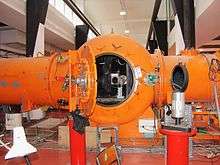
History
In 1962, the CNES (France’s National Centre for Space Studies) decided to build a low density and high-speed wind tunnel essential for aerodynamic and aerothermal studies in rarefied gas flows. This wind tunnel called SR3 was located in the Aerothermodynamics Laboratory from the CNRS (France's national scientific research center) in Meudon. The construction of the facility was delegated to the SESSIA (engineering consultants for aeronautical industrial works) and was achieved in 1963. The wind tunnel was then moved to the ICARE Laboratory in Orléans in 2000, as a result of the merging of the Aerothermodynamics Laboratory and the LCSR (Combustion and Reactive Systems Laboratory). Then, it was renamed MARHy which is the acronym for Mach Adaptable Rarefied Hypersonic.
Technical details
MARHy is a unique facility in Europe delivering low pressure, super/hypersonic flow in a continuous mode. It is an open-jet wind tunnel. Dimensions: The wind tunnel is composed of 3 parts:
- a settling chamber: length of 2.6 m, internal diameter of 1.2 m. It is equipped with a flow breaking cone.
- a cylindrical test chamber: length of 3.5 m, diameter of 2 m.
- a diffusor going to the pumping room: length of 10m and diameter of 1.4 m.

Regarding the flow conditions and the rarefaction level, two types of pumping groups are available. 19 different types of flows can be generated, requiring specific generating conditions and thus, relying on variable vacuum pressures. Indeed, for high densities flows, 14 Roots blowers are associated to 2 rotary vacuum pumps. A wide range of nozzles with various exits shapes going from cylindrical to a truncated cone with an interchangeable col allows an operating domain from subsonic to hypersonic. When a diffusor is added in the extension of the test chamber, a static pressure below 1 micrometer of mercury can be reached.
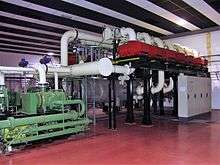
| Mach number M | Reynolds number Re/cm | Static Pressure P1 (Pa) | Static Temperature T1 (K) |
|---|---|---|---|
| 0.6 | 3.7x101 | 27 | 280 |
| 0.8 | 5.3x101 | 27 | 266 |
| 2 | 6x104 | 6.1x103 | 163 |
| 2 | 2.7x101 | 2.7 | 163 |
| 2 | 8x101 | 8 | 163 |
| 4 | 1.8x102 | 2.7 | 70 |
| 4 | 5.7x102 | 8 | 70 |
| 4 | 5x103 | 71.1 | 70 |
| 6.8 | 3.55x102 | 5.02 | 97 |
| 12 | 1.19x103 | 1.38 | 27 |
| 14.9 | 4.58x103 | 3.17 | 22 |
| 15.1 | 1.10x103 | 0.72 | 21 |
| 15.3 | 4.24x102 | 0.26 | 21 |
| 16 | 11.17x102 | 0.58 | 20 |
| 16.5 | 59x102 | 3.15 | 20 |
| 18.4 | 7.52x103 | 2.98 | 18 |
| 20 | 8.38x102 | 0.21 | 14 |
| 20.2 | 2.85x102 | 0.07 | 13 |
| 21.1 | 6.68x103 | 1.73 | 14 |
Tunnel instrumentation
Various types of diagnostics are associated to the wind tunnel MARHy: Pitot Probes, Pressure sensors for parietal measurements, Heat transfer gauges, Infrared thermography camera, iCCD camera & luminescence technique, Aerodynamic balance, Electrostatic probes, Optical spectrometry (near IR, visible and VUV), Electron gun. They are employed for fundamental and applied studies in the fields of Compressible Aerodynamics, Aerothermodynamics, Atmospheric entries and Gas and Plasma Physics.
Research Applications
The wind tunnel MARHy is extensively used for fundamental and applied research of fluid dynamic phenomena in rarefied hypersonic and supersonic flows.
- Flowfied characterization of hypersonic and supersonic rarefied flows around models (density, aerodynamic forces, pressure...)
- Structure of wakes in hypersonic and supersonic rarefied flows
- Atmospheric entry aerodynamics at high altitude
- Plasma flow control
- Space debris atmospheric entry
[3],
[4],
[5],
[6], …
[7],
[8],
[9],
[10],
[11],
[12],
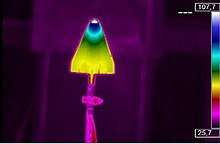
Gallery
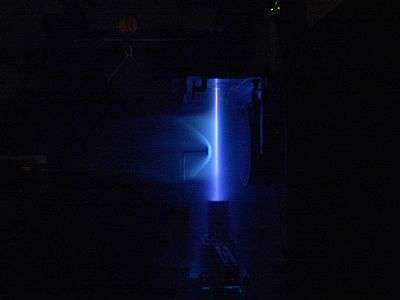 Photo of the experiment with an electron gun (ONERA).MARHy/ICARE (viviana Lago)
Photo of the experiment with an electron gun (ONERA).MARHy/ICARE (viviana Lago)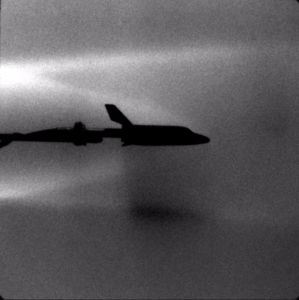 iCCD image of an Hermès model in a Mach 20 flow.MARHy/ICARE (viviana Lago)
iCCD image of an Hermès model in a Mach 20 flow.MARHy/ICARE (viviana Lago)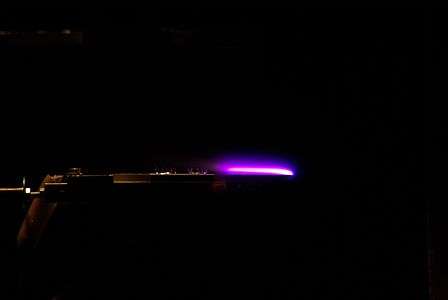 Photo of the glow discharge with a plasma actuator.MARHy/ICARE (viviana Lago)
Photo of the glow discharge with a plasma actuator.MARHy/ICARE (viviana Lago)
References
- [[Category:wind tunnel] Semi-protection: High level of IP vandalism. ~~~~ ICARE Laboratory, CNRS, Orléans
- MERIL, the European facilities platform
- Sandra, Coumar and Lago, Viviana (2017). "Influence of Mach number and static pressure on plasma flow control of supersonic and rarefied flows around a sharp flat plate". Experiments in Fluids. 58 (6): 74. Bibcode:2017ExFl...58...74C. doi:10.1007/s00348-017-2346-6.CS1 maint: multiple names: authors list (link).
- COUMAR, Sandra. (2017). "Etude des mécanismes physiques induits pas un actionneur plasma appliqué au contrôle d'écoulements raréfiés super/hypersoniques dans le cadre de rentrées atmosphériques". Thèse de doctorat. Université d'Orléans. Cite journal requires
|journal=(help). - Sandra, Coumar and Joussot, Romain and Lago, Viviana and Parisse, Jean-Denis (2016). "Influence of a plasma actuator on aerodynamic forces over a flat plate interacting with a rarefied Mach 2 flow". 26 (7). International Journal of Numerical Methods for Heat & Fluid Flow: 2081–2100. Cite journal requires
|journal=(help)CS1 maint: multiple names: authors list (link). - Joussot, Romain and Lago, Viviana (2016). "Experimental investigation of the properties of a glow discharge used as plasma actuator applied to rarefied supersonic flow control around a flat plate". 23 (2). IEEE Transactions on Dielectrics and Electrical Insulation: 671–682. Cite journal requires
|journal=(help)CS1 maint: multiple names: authors list (link). - Joussot, Romain and Lago, Viviana and Parisse, Jean-Denis (2015). "Quantification of the effect of surface heating on shock wave modification by a plasma actuator in a low-density supersonic flow over a flat plate". Experiments in Fluids. 56 (5): 102. Bibcode:2015ExFl...56..102J. doi:10.1007/s00348-015-1970-2.CS1 maint: multiple names: authors list (link).
- Coumar, Sandra and Joussot, Romain and Parisse, Jean-Denis and Lago, Viviana} (2015). "Effect of surface heating on shock wave modification by a plasma actuator in a rarefied supersonic flow over a flat plate". 3562. 20th AIAA international space planes and hypersonic systems and technologies conference. Cite journal requires
|journal=(help)CS1 maint: multiple names: authors list (link). - Parisse, Jean-Denis and Kudryavtsev, Alexey N and Lago, Viviana} (2015). "Effect of surface heating on shock wave modification by a plasma actuator in a rarefied supersonic flow over a flat plate". 7 (4). International Journal of Engineering Systems Modelling and Simulation: 271–278. Cite journal requires
|journal=(help)CS1 maint: multiple names: authors list (link). - Lago Viviana, Coumar Sandra, and Jousso Romain (2015). "Plasmas for High Speed Flow Control" (10). AerospaceLab. Cite journal requires
|journal=(help)CS1 maint: multiple names: authors list (link). - Lago, V and Joussot, Romain and Parisse, JD (2014). "Influence of the ionization rate of a plasma discharge applied to the modification of a supersonic low Reynolds number flow field around a cylinder". Journal of Physics D: Applied Physics. 47 (12): 125202. Bibcode:2014JPhD...47l5202L. doi:10.1088/0022-3727/47/12/125202.CS1 maint: multiple names: authors list (link).
- Joussot, Romain and Lago, Viviana and Parisse, Jean-Denis (2014). "Efficiency of plasma actuator ionization in shock wave modification in a rarefied supersonic flow over a flat plate". American Institute of Physics Conference Series. AIP Conference Proceedings. AIP Conference Proceedings. 1628 (1): 1146–1153. Bibcode:2014AIPC.1628.1146J. doi:10.1063/1.4902722.CS1 maint: multiple names: authors list (link).